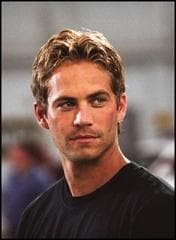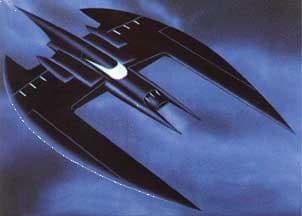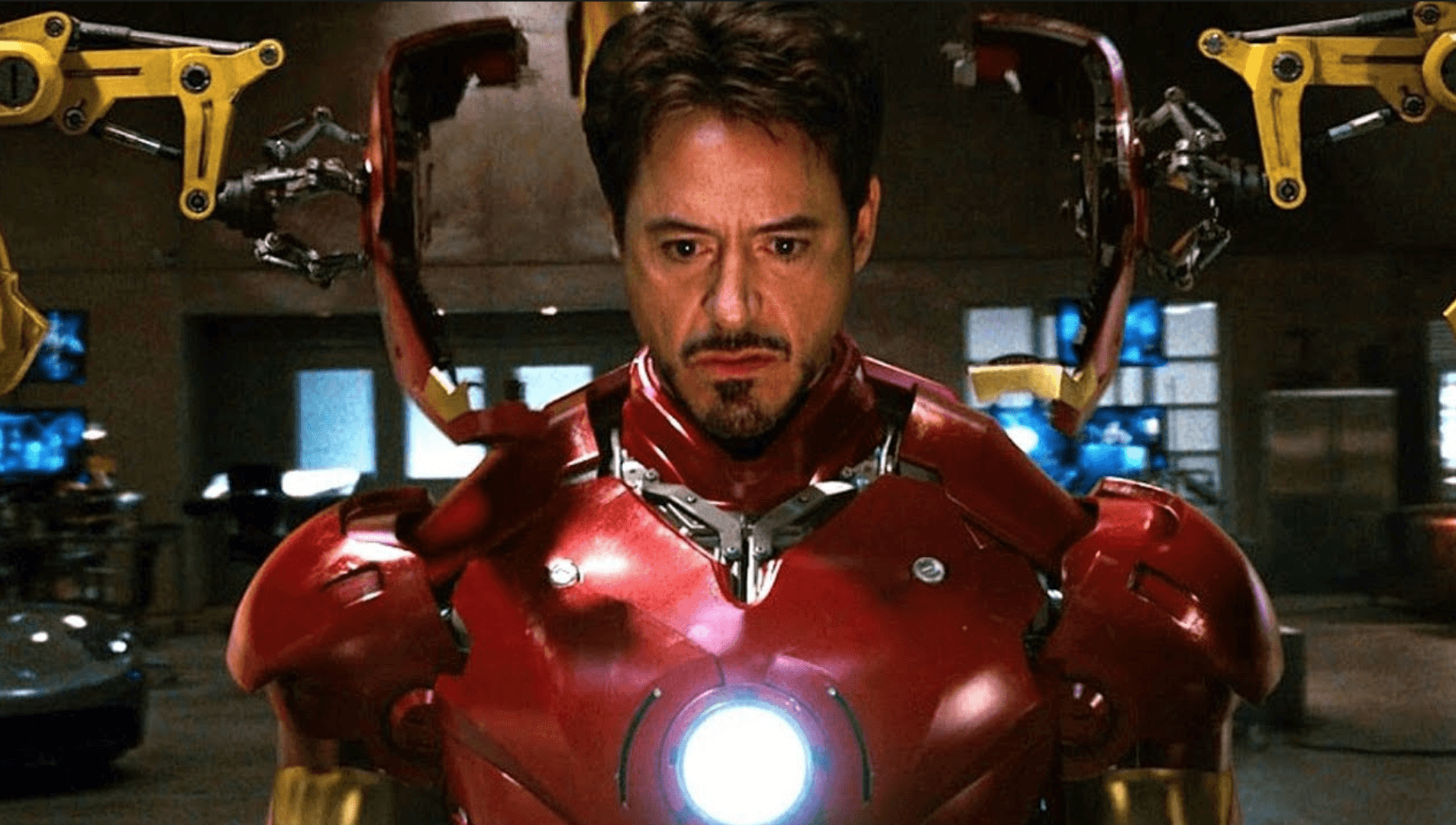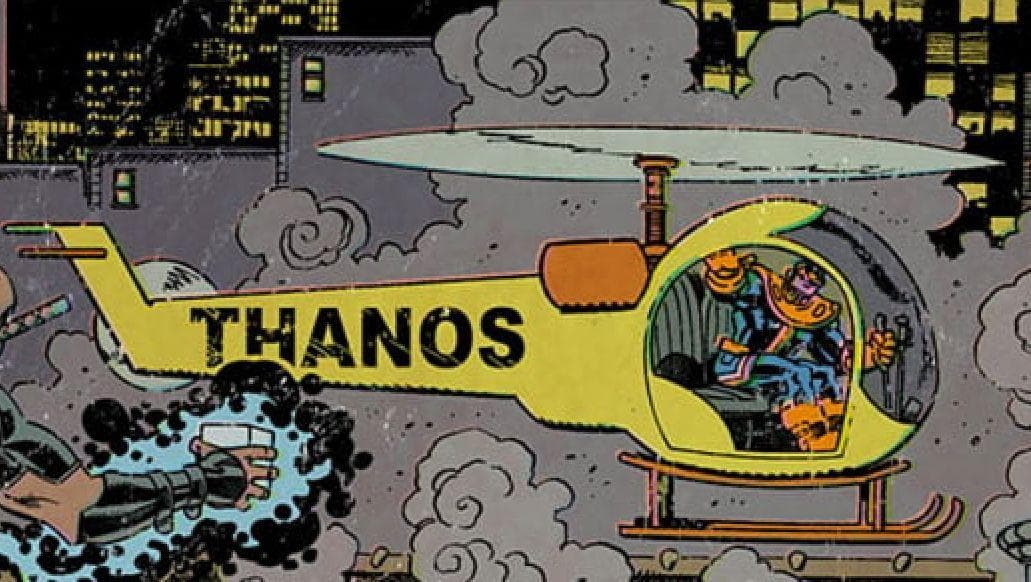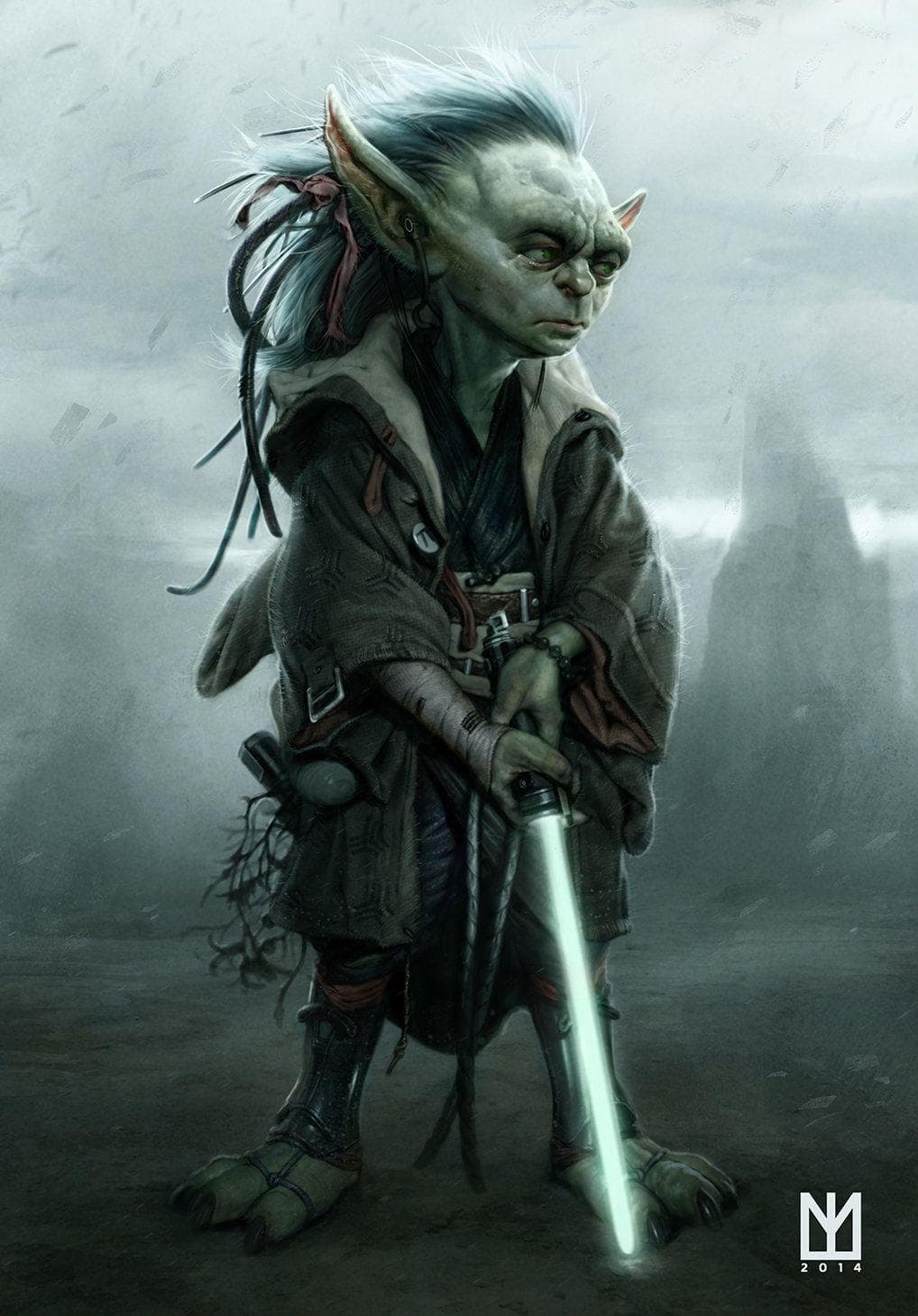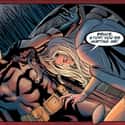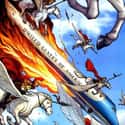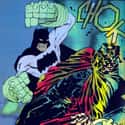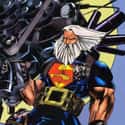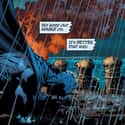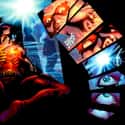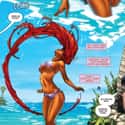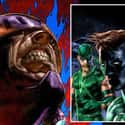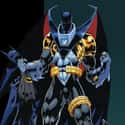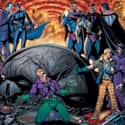(#1) Batman: The Widening Gyre
Whether you love his sense of humor and irreverent movies or you hate them, there's no question that Kevin Smith is a true comic book fan. References to comic books and comic book characters are ladled over everything he does, from his movies, to his SModcasts, to the AMC reality show Comic Book Men. Smith has even owned multiple comic book shops for decades, including Jay and Silent Bob's Secret Stash, which serves as the setting for many of his productions. But being a movie writer and lover of comic books isn't enough to guarantee a successful series, and Batman: The Widening Gyre (2009-2010) is an excellent case in point.
The story, written by Smith and illustrated by longtime friend Walt Flanagan, finds Batman embroiled in a conflict between Poison Ivy and Etrigan the Demon. Distracted by the reappearance of old flame Silver St. Cloud and the arrival of a violent new "hero" named Baphomet in Gotham, Batman blunders through just about every mission he embarks upon, requiring aid at every turn. His judgment apparently clouded by St. Cloud, the "world's greatest detective" drops his guard and reveals his identity to the clearly unstable Baphomet, who reveals himself to be the villain Onomatopoeia and promptly slits the throat of Batman's paramour.
Thankfully, only the first six issues of the intended 12-issue series were ever published. Not only is Smith's Batman a clumsy fool who overestimates his abilities and soils himself when things go wrong, but he so disbelieves that he is worthy of love that he drags St. Cloud out of the car by her hair and roughs her up to make sure she is not a robot. Sex and controlled substance references unnecessarily pervade The Widening Gyre, with Poison Ivy incapacitating Batman with synthesized weed and St. Cloud referring to Batman as "Deedee" because their first night of intimacy went into double-digit orgasms. The series has been called "the worst Batman comics," and DC has been bashed for Smith's hiring and called "so insecure that they beg for the table scraps of other media."
(#2) Amazons Attack
Comic book fans are pretty vocal about their disappointment with a series, story arc, or the characterizations of their favorite heroes, but they usually reserve their vitriol for the aisles of comic book shops or spread it anonymously online. Rarely has a title been so bad that a fan actually packed up the books they purchased and shipped them back to DC in protest, as at least one fan did with Amazons Attack! by Will Pfeifer and Pete Woods.
Launched as a six-issue limited series in April 2007, with seven tie-in issues across four other titles including Wonder Woman, Amazons Attack! finds the full fury of the all-female warrior society descending upon Washington, DC, in retaliation for Wonder Woman's illegal detention and torture by the Department of Metahuman Affairs. Accompanied by chimeras, hydras, cyclopes, "Stygian Killer Wasps," and other mystical creatures, the Amazons take out centuries of frustration with "Man's World" by mercilessly slaughtering any males they come across, including unarmed men and children. After decapitating the head of the statue of Abraham Lincoln at the Lincoln Memorial, the Amazons then attempt to assassinate the president of the United States, first on land, and then in the air, aboard Air Force One.
The series was supposed to define Wonder Woman and her purpose, both as an Amazon and as a superhero in Man's World, but she barely impacts the events of the story, relying on Supergirl, Nemesis, Batman - with a last-minute magic spell courtesy of Zatanna - and others to save the day, appearing in fewer than 30 pages of the entire 160-page story. Meanwhile, her entire race of Amazons are painted as morally bankrupt, bloodthirsty drones in service to uncaring "gods." Reviews of the series eviscerated the storyline, with one reviewer summing it up as an "unnecessary, unwanted, sexist, and kinda racist story that leads us all wonder, what the hell DC was thinking!"
(#3) 'The Dark Knight Strikes Again' Is A 'Ridiculous' Sequel With 'Weird' Art
Batman: The Dark Knight Returns took the comic book world by storm when it debuted in February 1986. The first issue sold over a million copies and the four-issue series is now widely considered one of the most important and influential comic books of all time. Frank Miller's tale of an aging Batman coming out of retirement to stop the rising tide of violence in Gotham City perpetrated by Two-Face, the Joker, and a violent gang called the Mutants has been called a "masterpiece of storytelling," and in 2005 made Time's list of the 10 best English-language graphic novels of all time.
So when Miller returned to tell another tale of a seething, aged Batman in the dark, twisted future world he created, anticipation was high - as were expectations that Miller's sequel, Batman: The Dark Knight Strikes Again, or DK2 (2001-2002), could live up to the original.
DK2 contained more heroes and a continuation of the sort of political satire found in the original, with Batman training his former enemies to rebel against Lex Luthor's corrupt government. But absent was anything even remotely revolutionary about his take on Batman or superheroes, in general. The story - which doesn't even really begin until the second of the three issues - is incoherent or just plain "ridiculous" at times. Worst of all, Miller's artwork is clunky, simplistic, and just plain "weird" throughout. Anatomy appears irrelevant and the features of some characters are so distorted they are almost unrecognizable from panel to panel. Splash and double-page splash pages, usually reserved for epic-scale, poster-worthy scenes are used more to meet page requirements than anything else, as they are simplistic and, like the series itself, fail to make any sort of "splash" at all.
(#4) The Man Of Steel Goes Full-On Punisher Before Offing Himself In 'Superman: At Earth's End'
We're sympathetic to DC writers. It can't be easy crafting original stories designed to challenge the hero when that hero has been around as long and is as powerful as Superman. There are only so many different types of Kryptonite or magic imps from another dimension to rely upon before it all starts feeling redundant. Those limitations, plus a 1995 release date - right smack-dab in the middle of the speculator bubble crash, when big guns and pouches were all the rage - make Superman: At Earth's End an almost forgivable entry in DC's Elseworlds line. Almost. As one reviewer put it, this comic falls into the category of "stories that simply get it wrong on every possible level imaginable."
The story takes place in a post-apocalyptic future and is a semi-sequel to Kamandi: At Earth's End. Earth's heroes are all but forgotten and Superman, sporting the look of a hermit on steroids, is greatly diminished due to lack of adequate sunlight. Dwelling in a hovering city that allows him to slowly regain his strength, he looks down upon the ruins of Gotham City and finds that the remains of his old friend Batman have been taken from their resting place, along with the bodies of his parents. Heading off to investigate in what would become his final mission, Superman encounters bat creatures, lion-men, robots, cyborgs, mutant SS troopers, and a pair of Hitler clones.
Though the basic premise is not all that bad on its own, noted poet, author, and comic book scribe Tom Veitch does not give us Superman, or even an approximation of the Superman that we all know and love. Though he can fly and is supposedly back up to strength, the Superman in Earth's End relies on weapons to do most of the work, including a gun so ludicrously huge that it would probably even make Rob Liefeld roll his eyes. Not only does he have no problem mowing down his enemies, but this Superman is so devoid of any semblance of hope that, after being mortally injured, he would rather give up and take his own life rather than live out his days as a *gasp* cyborg.
(#5) All Star Batman and Robin
- Comic Book Series
What do you get when you bring together Frank Miller, the writer who helped comic books mature in the 1980s with his revolutionary takes on Daredevil and Batman, and Jim Lee, the superstar artist who helped turn X-Men into the hottest property in the world in the early '90s, on a new title about the early adventures of Batman and Robin? An absolute mess, apparently.
All-Star Batman & Robin was much hyped and eagerly anticipated by just about everyone when it debuted on July 13, 2005. The first issue sold more copies than any other title from any publisher that year. Lee's artwork was spectacular, and it was still a novelty seeing it applied to DC characters after building his career on Marvel and Image characters. But Miller's characterizations were way off the mark, even considering that All-Star is set within the alternate version of the DC Universe that leads to Batman: The Dark Knight Returns.
Miller paints Batman as crude, ruthless, and sadistic, and not as a result of years spent fighting crime in the blood-soaked alleys of Gotham, but since he was a child and still had parents. He swears, doesn't shave, probably doesn't bathe, has impulsive sex on the ground in a filthy alley, and he basically kidnaps Dick Grayson and tortures him into becoming Robin. Miller's Batman leaves his "ward" alone in a cold, wet cave and tells him to eat the rats scurrying about if he gets hungry. He's not looking to protect Dick so much as tear him down through mental and physical abuse and remake him into a proto-Batman.
One notorious exchange between Batman and Dick has come to signify the series itself: "What are you, dense?... Who the hell do you think I am? I'm the goddamn Batman!"
And it's not just Batman that is off: Superman is an "idiot" who throws tantrums, Wonder Woman is a man-hating zealot, Green Lantern is a buffoon, and Black Canary is a bloodthirsty psychopath.
To put it mildly, the series was not well received by critics, with many calling it "the worst Batman comic" or "the worst comic ever" made. Ten issues were published sporadically between 2005 and 2008, with issue #10 recalled and reprinted because one of Miller's many four-letter words slipped past the censors. Then, the series simply... stopped, without any resolution of the story. It was later announced that the series would continue on to its originally intended conclusion under the new title Dark Knight: Boy Wonder. The series, slated for release in 2011, was never published.
(#6) J.T. Krul Turns Red Arrow Into A Misogynistic Psycho In 'Justice League: The Rise of Arsenal'
The demise of his daughter during the destruction of Star City by Prometheus in Justice League: Cry for Justice, coupled with the loss of his right arm, sends Roy Harper down the violent, delusional, and self-destructive path that leads to his abandonment of the Red Arrow persona he spent years cultivating. As chronicled in Justice League: The Rise of Arsenal (2010), Roy's inability to perform - both as a hero and as a lover - or to exact revenge upon Prometheus himself, along with hallucinations brought on by his unstable mental condition and a tragic return to substance use, turn him into the violent vigilante Arsenal.
The "Rise" in the title gives the impression of ascendance; however, there's nothing but "descent" in the four-issue miniseries written by J.T. Krul. The already tragic life of Roy Harper becomes even sadder and more twisted as the series progresses: Roy crudely rates his romantic partners in his mind while in the midst of battle; attempts, unsuccessfully, to have hate sex with the grieving mother of his daughter; and beats a street gang with the body of a deceased cat that he believes possesses his daughter's spirit. The series has been politely called "not very good," with others decrying it as "bad and riddled with inaccuracies and general weirdness," but most declaring it "the worst comic of all time."
(#7) Jason Todd Becomes A Monster And Dick Grayson A 'Sleazy' Model In 'Brothers in Blood'
Bruce Jones is an Inkpot Award-winning writer (2004) who has penned many memorable storylines in his decades-long career, including a fantastic run on Marvel's The Incredible Hulk. But when Jones jumped ship from Marvel to DC in 2005, he went from revitalizing the Hulk creatively and financially to nearly destroying two classic DC characters in what is considered by many to be one of the worst story arcs of all time.
In Nightwing #118-124 (2006), later collected as Nightwing: Brothers in Blood, Jones propels former Robins Dick Grayson and Jason Todd into the future as part of the "One Year Later" company-wide event that followed Infinite Crisis. Dick, needing a change of pace, moves to New York City to continue to fight crime as Nightwing. Jason has the same idea and also moves to NYC to fight crime as Nightwing, but as a darker, more violent version of his Bat-brother's alter ego. Naturally, the two come to blows...
If that were the extent of the storyline, Brothers in Blood would likely not have been "almost unanimously panned" and an arc so notorious that it made this list. Unfortunately, Jones wrote in a bizarre subplot where Jason turns into a mutant tentacle-monster and painted Dick as a depressed, "somewhat sleazy" character who gives up police work to become a male model, have promiscuous relations, and make culturally inappropriate jokes about Native Americans.
(#8) 'Red Hood and the Outlaws' Reduced Starfire To Fanboy Eye Candy
Princess "Kori" Koriand'r, AKA Starfire, had already been a popular character for decades before her outstanding characterization on the Teen Titans cartoon endeared her to a whole new generation of DC fans. As a cartoon character aimed at elementary school-aged children, sexuality was never really a part of her personality, though Robin clearly crushed on her and definitely had an issue with her kissing strangers to learn their language. In contrast, the comic book version of Starfire was always more vivacious and curious about human romantic customs, even in her early appearances as a teenage character.
But when Starfire was reintroduced in Red Hood and the Outlaws #1 (November 2011) as part of the company-wide continuity reboot known as The New 52, her sexuality became her primary asset. Writer Scott Lobdell has a young child posting "voyeur" photos of her on the internet and her own teammates, Red Hood and Robin, ogling her and questioning her morals, while artist Kenneth Rocafort draws one "cheesecake" pose after another.
The series was greeted almost immediately with negativity from fans, including at least one devastated 7-year-old girl, and DC apparently knew the controversy was coming, but did little to alter course. After the 7-year-old girl's disappointment caught fire on the internet, DC tweeted terse statements about appreciating "dialogue" on the topic, while almost chastising the girl (or her parent) for buying a book intended for slightly older children. The characterization didn't sit well with some DC staffers, either, feeling Lobdell equated "being a strong woman with being, frankly, a sl*t," and an unnamed source stated it was suggested to Lobdell that he "accentuate" Kori's "past as a sex slave" as a way to justify the new Starfire.
(#9) Justice League: Cry for Justice
- Comic Book Series
After the slaying of Martian Manhunter and the apparent demise of Batman during Darkseid's bid to recreate reality in Final Crisis, Green Lantern Hal Jordan decides that the Justice League needs to be more proactive. With a cobbled-together team of B- and C-list heroes that includes Green Arrow, Atom (Ray Palmer), Starman (Mikaal Tomas), Congorilla, Freddy Freeman, and Supergirl, the new, "extreme" Justice League team abandons "justice" in favor of "revenge," and ditches some of their morals along the way. But even the team's more aggressive approach to crime-fighting - including using torture to extract information - can't stop millions of casualties, including the demise of cute, little grade-school-age Lian Harper, daughter of Roy Harper, AKA Speedy (later Arsenal and Red Arrow).
Though writer James Robinson previously wrote such acclaimed works as The Golden Age and the series Starman, and was even nominated for an Eisner Award for his work on Justice League: Cry for Justice, the series was simply too dark and too wordy. Rather than rely on the beautiful art of Mauro Cascioli - also nominated for an Eisner for his work on the series - Robinson attempted to drive the plot with pithy dialogue, stale speeches about "justice," and countless yawn-inducing "thought" captions.
(#10) The Man of Steel Gets Weird Powers And Two Terrible Costumes In 'Superman Red/Superman Blue'
After years of declining sales, DC decided to wake up comic book fans - and wider popular culture - to the importance of Superman by offing him in the much-publicized "The Death of Superman" storyline that ran from December 1992 to October 1993. The gimmick worked and Superman #75 (January 1993), in which the Last Son of Krypton succumbs to his injuries after finally defeating Doomsday, raked in $30 million in its first day of sales. After a three-month hiatus, the Superman books returned with four Superman pretenders to the throne - Eradicator, Superboy, Steel, and Cyborg Superman - and fans ate them up, making them the best-selling comics of 1993.
Of course, the real Superman was never really "dead" and eventually returned, albeit with a mullet and a red-and-blue suit of a darker tint. After a few years, Superman settled back into his old role as the stodgy "Big Blue Boy Scout" of comics and sales began to flag again. Rather than making more compelling stories for their flagship character, DC decided to continue the gimmick of messing with Superman's classic formula and took away his iconic costume, his powers, and even his skin tone in "Superman...Reborn!" in Superman #123 (May 1997). The "reborn" Superman had blue skin and painful electricity-based powers that required a blue-and-white "containment suit" that apparently didn't need to cover his face or the top of his head.
A year later, DC doubled down on the terrible new Superman by borrowing an idea from a weird 1960s story in Superman Red/Superman Blue #1 (February 1998). Though initially of the same mind, the two Supermen eventually grow independent of one another, with Superman Blue being cooler and more intellectual (because he's, you know, blue), and Superman Red being more hot-tempered and impulsive (because he's red, obviously). Neither of them appealed to Lois Lane, or to fans, and Superman's "electric boogaloo" phase has been a running joke ever since. Time has apparently given DC some perspective, because even the publisher pokes fun at the storyline now. In Superman #154 (March 2000), Brainiac slays a copy of Superman Blue and muses, "He's not Superman... and never will be," while in Dark Knights: Metal #4 (February 2018) Superman Blue is explained away as one of Clark Kent's "nightmares."
(#11) Before Watchmen
Alan Moore and Dave Gibbons changed comic books forever with their now-classic 12-issue miniseries Watchmen (1986-1987). The series, set in an alternate universe, presents a world changed by the presence of superheroes - the US won the Vietnam War and Nixon never resigned - and focuses on the investigation of the slaying of a retired superhero and a conspiracy with global implications. Moore and Gibbons deconstructed bright and shiny superheroes and built them back up as flawed characters with serious neuroses, pathologies, and deviant sexual appetites in a world filled with scandal and political intrigue. The series thrilled, shocked, and inspired a whole new generation of comic book fans and creators. It became the only graphic novel to make Time's 100 Best Novels list and has been hailed as "the greatest comic book ever written."
Had DC left well enough alone, Watchmen would have remained a title spoken of with reverence by fans and respect by the greater pop culture community. Instead, executives who saw Watchmen as an under-utilized intellectual property and creatives who dared think they could somehow add to or improve upon an already perfect story disgorged eight limited series and a one-shot (a total of 37 issues) that did nothing but water down the title's legacy. Despite top-notch talent like J. Michael Straczynski, Darwyn Cooke, Adam Hughes, and original Watchmen contributor Len Wein, the set of series - released in 2012 when fans had already seen decades of gritty deconstructions - lacks originality and makes no effort to integrate history, culture, philosophy, or psychology into its narratives the way that Moore and Gibbons did in the original. As the LA Times puts it, there's nothing transformational about Before Watchmen - it's just "a bunch of stories about a bunch of superheroes."
(#12) 'Batman: Odyssey' Is Neal Adams's Bizarre And Incomprehensible Swan Song
Neal Adams is one of the most celebrated comic book creators of all time and one of the last living titans of the industry still actively involved in comics. His dramatic, realistic art style helped revitalize the look of DC characters in the late-'60s and early-'70s with seminal runs on Batman and Green Lantern/Green Arrow. He later left contract work for DC and Marvel and founded his own company, Continuity Comics, to launch series starring his own characters, most notably Megalith. For his many contributions to comic books and to creator rights over his 60 years in the industry, Adams has been honored with inductions into the Will Eisner Comic Book Hall of Fame (1998), the Jack Kirby Hall of Fame (1999), and the Joe Sinnott Hall of Fame (2019).
Because of his legendary status, DC gave Adams wide latitude to tell whatever kind of story he wanted when he deigned to return to write and draw a new Batman story in 2010 after a decades-long hiatus. The result was the six-issue Batman: Odyssey (Vol. 1) miniseries (2010-2011), a rambling, bizarre story so confusing and challenging to get through, let alone understand, that it almost defies description. Adams puts Batman through the wringer, launching just about every major villain he has ever had at him in rapid-fire succession, all the while challenging the Dark Knight's - and Robin's - views on guns and lethal force.
The series was highly anticipated and enthusiastically received at first, but proved too bizarre and "insane" for even ardent fans. Adams called it his best work, defending it as only one chapter in a much larger "book" about Batman, but DC only published seven more issues of Volume 2 before deciding to close the book on Odyssey for good.
(#13) Batman Gets The 'Extreme' '90s Treatment In 'Knightquest'
The wildly popular Knightfall storyline that kicked off in Batman (Vol. 1) #492 (May 1993) would grow to become one of the biggest and most elaborate event storylines in the Dark Knight's publishing history up until that point. The three-act story - Knightfall, Knightquest, and KnightsEnd - was told over 38 issues of seven different titles and completely altered the status quo in Gotham City, with lasting ramifications for Batman and DC continuity for years to follow. Elements of the story, including Bane and "the breaking of the Bat" have even seeped into wider popular culture, including celebrated filmmaker Christopher Nolan's Dark Knight Saga of films.
The series is only marred by its terrible second act: Knightquest. After Batman is worn down and crippled by Bane in Knightfall, Bruce Wayne decides in Knightquest to appoint a replacement to protect Gotham City. Rather than choose Dick Grayson, his longtime ward and the original Robin who has become the badass adult hero Nightwing, Bruce chooses... Jean-Paul Valley, who had only debuted as the flame-wielding holy warrior Azrael a year prior.
Valley decides Bruce's Batman has been too warm and fuzzy and outfits his Bat-suit with armor, razor-sharp Batarangs, lasers, and a flamethrower, among other weapons. The increasingly unstable new Batman dispenses "justice" with extreme prejudice, often injuring, crippling, or, in the case of the serial slayer Abattoir, ending them, while simultaneously tarnishing Batman's reputation and straining his relationship with law enforcement. Meanwhile, Bruce falls in love with his metahuman physiotherapist Shondra Kinsolving and attempts to rescue her from her adoptive brother Benjamin Asplin, AKA Asp. In the end, Asp is slain and Bruce's back is healed, but poor Shondra ends up with the mind of a child and has to be institutionalized.
Knightquest and Valley's "extreme" Batman were so disliked by fans that DC basically attempted to ignore it by omission. The publisher waited 18 years to collect the first part, "The Search," and another five before collecting the second part, "The Crusade," while the rest of the series had been available as reprints or in trade paperback collections for years.
(#14) 'Countdown' Is An Expensive Year-Long Story That Doesn't Matter
For 51 straight weeks - beginning with issue #51 and counting backwards down to issue #1 - Countdown (renamed Countdown to Final Crisis as the series neared its conclusion) trotted out just about every DC character of note to tell a rambling, overlapping story that ended up being completely inconsequential to DC continuity as a whole. Following on the heels of another weekly series, 52, but keeping the story within the context of the greater DC timeline instead of a "lost" year, Countdown was designed to restructure the world of the New Gods and set up Darkseid as the ultimate villain in anticipation of his (next) attempt to rewrite reality in the Final Crisis miniseries that immediately followed its conclusion in DC Universe #0 (June 2008).
The series revolves around Darkseid's plot to control the multiverse in a cosmic game of chess in which he uses heroes and villains from various Earths as pawns. To clear his path to victory, Darkseid attempts to pit the Monitors tasked with safeguarding the multiverse against Monarch and the Crime Society. Unbeknownst to all, however, Darkseid's opponent is the rogue Monitor Solomon, who wishes to control the multiverse himself. Various interconnecting plot lines reveal that New Gods are being slain, Superboy-Prime is back - now as Superman-Prime - and looking for a "perfect" Earth, and a virus is running rampant across parallel Earths, turning people into OMACs for assimilation by Brother Eye.
There are some fun scenes and interesting iterations of characters, but too many scenes are repeated in multiple issues without added context and the art varies wildly from issue to issue. Countless characters perish throughout the series - including Darkseid himself - but in the end, any victories were hollow and any deaths meaningless as DC promptly resurrected Darkseid and launched into its next "event," Final Crisis.
New Random Displays Display All By Ranking
About This Tool
DC Comics created great and popular characters such as Superman, Batman, and Wonder Woman, who worked hard to fight for justice and defend the innocent. On the other hand, some little-known and embarrassing DC comic arcs characters have also sparked discussion. Over time, it is easy to tell who is popular, acceptable, and who is ignored.
A large number of DC movies were released to show their most popular characters and stories, and the distributors are doing everything they can to make sure that fans forget some annoying DC comic arcs. The random tool lists 14 of the most hated DC comic arcs for fans.
Our data comes from Ranker, If you want to participate in the ranking of items displayed on this page, please click here.



